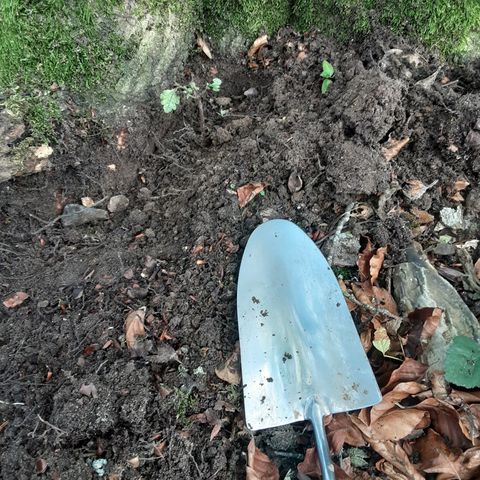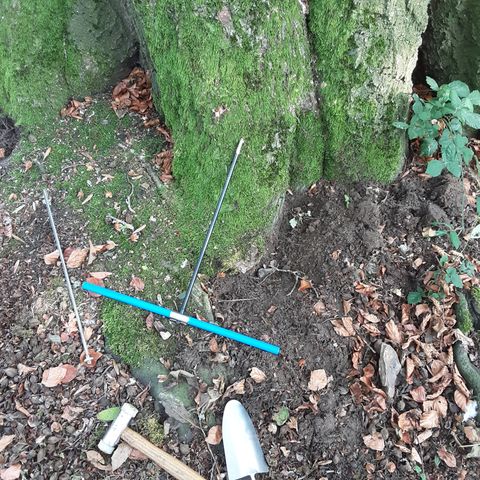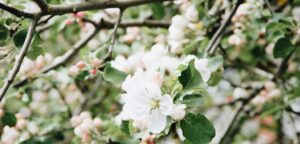
The customer’s gardener had noticed that a large Beech tree was looking sparse in the tree canopy and mentioned it to the owner. A tree surgeon had worked on it two or three years ago but it had deteriorated since then.
The tree was the main landscape tree when looking out from The Old Rectory and in its time had been present in many family images.
We were called to look at the tree in October and carry out a safety inspection.
The tree was near other buildings and the main driveway.
The tree roots and buttress seemed decayed but there was no fungi. A careful examination took place for more evidence. Leaves on the tree were small and yellow and there were a great many dead branches.
The owner was appraised, and she was shocked. The tree was approaching the end of its time.



Understanding Root Decay
Root decay, often referred to as root rot, is a fungal infection that affects the roots of trees. Beech trees are particularly vulnerable to several types of root decay fungi, such as Armillaria mellea (oak root fungus), Meripilus giganteus, and Heterobasidion annosum (both root rot fungus). These fungi invade the tree’s root system, causing decomposition of the roots, which ultimately weakens the tree’s structural integrity and its ability to absorb nutrients and water.
Causes of Beech Tree Root Decay
Fungal Pathogens: Root decay is primarily caused by fungal pathogens that infect the tree’s root system. These fungi are often present in the soil and can enter the tree through wounds or weaknesses in the roots. Stress factors, such as drought, flooding, or damage to the roots, can make beech trees more susceptible to fungal infection.
Soil Conditions: Soil properties play a crucial role in the development of root decay. Beech trees are sensitive to changes in soil moisture levels and quality. Poorly drained or waterlogged soils create an environment favourable to root decay fungi.
Symptoms of Beech Tree Root Decay
Crown Thinning: The tree’s canopy may begin to thin out, with a decrease in leaf density and overall vigour.
Yellowing Leaves: Leaves may turn yellow or show signs of premature autumn colouration even during the growing season.
Dead Branches: Portions of the tree may die back, with dead branches and twigs present in the canopy.
Mushroom Growth: Fruiting bodies of the root decay fungi, such as mushrooms or conks, may appear at the base of the tree.
Weakened Structure: Trees affected by root decay may become structurally unsound, making them more susceptible to wind and storm damage.
Beech trees play a crucial role in forest ecosystems. They provide habitat and food for various wildlife species and contribute to the overall biodiversity of the forest. When beech trees succumb to root decay, it can have far-reaching ecological consequences:
Nutrient Cycling: Beech trees are involved in nutrient cycling in the forest ecosystem. Their decay can affect the availability of essential nutrients in the soil.
Succession: The death of beech trees can influence the composition of the forest community, as other species may fill the ecological niche left vacant by the dying trees.
Management and Conservation
To manage and conserve beech trees affected by root decay, it is essential to take several steps:
Early Detection: Regular monitoring of beech trees for signs of root decay is crucial. Identifying and addressing the disease in its early stages can improve the chances of tree survival.
Soil Management: Improving soil drainage and reducing compaction can help prevent the development of root decay-friendly conditions. Mulching and air spade use can help loosen up the soil.

What happened to the tree?
The tree owner called up the tree officer as the tree was significant, good relations with tree officers are essential as we all care about the trees. It was not under a protection order which makes things easier.
The tree owner wanted to keep the tree as they were sentimentally attached to it. So with delicate negotiations plans were made. The tree is being monitored by its owner and their gardener for the next 12 months before any action may be taken.
Of course, our advice and reports are underpinned by the potential risk.
If you have a tree you are worried about, don’t hesitate to call us at Ace of Spades Gardens.









